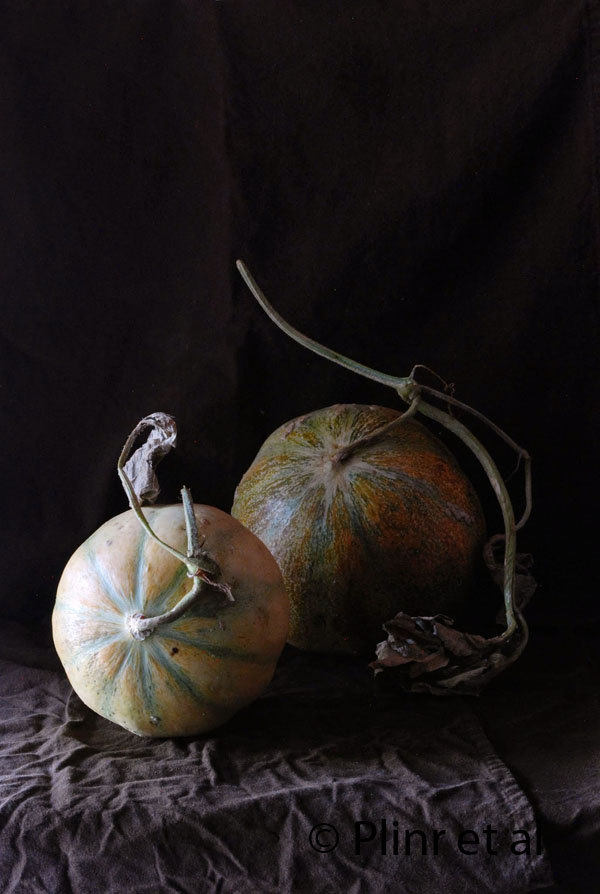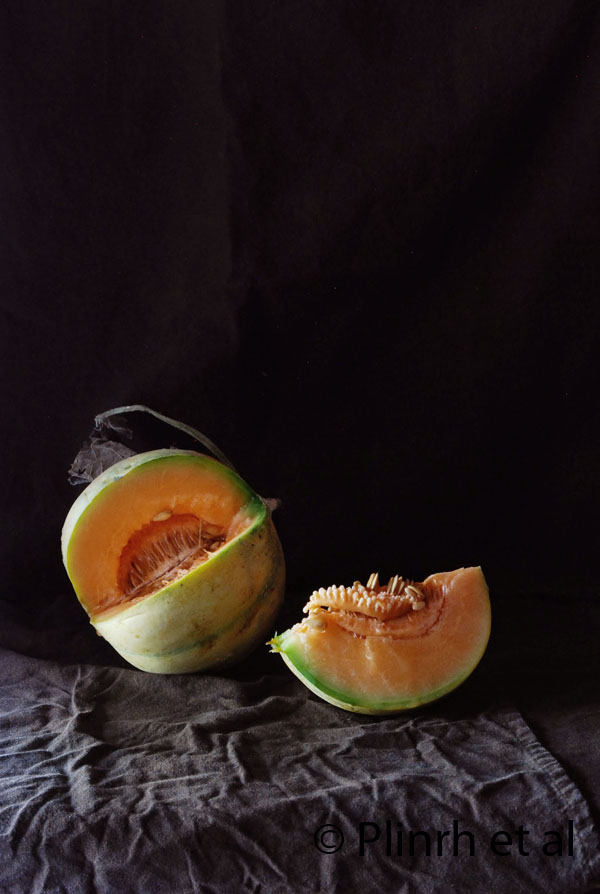French melons and plums
Farmers' markets often offer an enticing variety beyond the anemic choice offered at the local supermarket or even big-box convenience stores. The one I like to visit as part of my lazy Sunday ritual has a good mixture of vendors selling baked goods, fruits, vegetables, meats, and seafood. One or two vendors always bring uncommon and rare varieties of fruit that are usually easily bought in Europe. I still haven't found anyone in US growing those aromatic sweet gariguette strawberries I saw and ate in Paris. However, in the last month or so I was excited to find French melons and plums.
Translated to 'Little Gray of Rennes', Cucumis melo 'Petit Gris De Rennes' originated in the garden of the Bishop of Rennes nearly four hundred years ago. Its astonishing survival to the present day is unquestionably due to its fantastic brilliant. Amy Goldman writes enthusiastically about 'Petit Gris De Rennes' in Melons for the Passionate Grower (2002): "The Petit Gris de Rennes is so good it gives me the chills. As wonderful as Charentais is, Petit goes a baby step further, making it la creme la creme of French melons. You will blink your eyes with disbelief when you sample its sweetness, which is more like brown sugar than white. it will melt on your tongue, and your mouth will water for more." Her enthusiasm is not unfounded for my friends and I just closed our eyes, incredulous at the intense flavor of its orange flesh. My friend's father could not stop talking about the melon long after he had a taste. Unless you grow the melon yourself, having one to taste is not easy. One Sunday, Tom Culton of Culton Organics happened to have a stack of mixed melons, one of which was 'Petit Gris De Rennes', whose fragrance filled the warm brick quarters of the Headhouse in Society Hill. Seeing them set my heart racing, although $5.00 per melon was expensive at first. Goldman goes on to reveal that in France, the melon is grafted onto squash rootstock for Fusarium resistance and trained against the glasshouse walls to protect the fruits. There is even a syndicate of growers headed by Marie-Thérèse Rescan that sets the standards by which 'Petit Gris De Rennes' are grown.
Picking 'Petit Gris De Rennes' at its optimal ripeness means paying attention when the speckled gray-green skin loses its indumentum and becomes suffused with mustard. The perfume becomes more pronounced at this stage, and sometimes the fruit will slip off without effort from the vine.
From the Poitou-Charentes region of western France is Charentais whose flesh is equally ambrosial as 'Petit Gris de Rennes' and reportedly delicious with prosciutto or simply drizzled with port. The Charentais lacks the distinctive netting of the typical cantaloupes in United States for its rind is smooth and creamy white except for the green ridges that mark the quarters. It is not a large-sized variety since one can easily fit the palm of an adult's hand, but size is independent of flavor (just like those fraises des bois). Charentais is not as easy as 'Petit Gris de Rennes' to grow since the vines are highly susceptible to powdery mildew and the right combination of light, heat, and moisture can influence the taste of the ripening fruit. The fruits do not always slip when they are ripe, therefore the best telltale method is to lift them close to the nose for any perceptible aroma. If the aroma is perfumed and the skin having a light radiant glow, then the fruit is ready for harvesting. It does call for some patience and experience.
Once you sample these French melons, it's easy to understand why Montaigne said, "Je ne suis excessivement desireux ny de salades, ny de fruits, sauf les melons (I am not excessively fond of salads or of fruits, except melons.)."
Melons are not only fruits that the French and other Europeans seem to excel in growing and eating. Plums, essentially small European varieties, do not seem to be popular here in US as they are in Europe where people enjoy them in tarts and liquors. One of the plums I enjoyed eating in Europe and Australia was the mirabelle plum, recognizable by its oval shape about the size of a quail's egg and dark yellow flecked with orange. The Lorraine region in France is considered the center of world production for mirabelle plums, and the European Union has recognized the mirabelle de Lorraine as a geographically distinctive product. The mirabelle de Lorraine is even accorded its festival complete with foods, a parade, and the coronation of the Mirabelle Queen during August in Metz. I was excited to find them sold at the farmers' market in Philadelphia and purchased 3 lbs for a tart. The plums had excellent flavor - not cloying sweet like those hyped plucots, but sweet enough with some acid tang. So possessive was I over them that I refused to share them when friends asked for a sample.
~Eric










